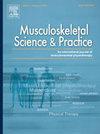Quality indicators for the community care of MSK conditions: An online modified-Delphi study
IF 2.2
3区 医学
Q1 REHABILITATION
引用次数: 0
Abstract
Background
Quality indicators can be used within healthcare to measure and benchmark performance. Variations in the access and quality of healthcare for musculoskeletal conditions highlights the need for a nationally agreed set of indicators.
Objectives
The study's primary aim was to develop a set of care quality themes and indicators for musculoskeletal community care.
Methods
An online Delphi process was used, that included clinicians, managers, researchers, and patients. In round one, participants rated 79 indicators, across six care quality themes, for their importance to quality community musculoskeletal care. Following this, participants discussed the results of the first round in an online panel and then re-rated indicators in a second-round survey. The panel discussion focused on a) the importance rating of indicators, and b) the wording of care quality themes. Consensus for high importance was set at ≥60% in both rounds of the study.
Results/findings
Forty-six individuals participated in the first round of the study, with 21 participating in the second round. After the second round, six care quality themes emerged: 1) Optimising patient access and assessment, 2) Optimising patient education, self-management, and rehabilitation, 3) Optimising personalised care, 4) Optimising diagnosis, imaging, investigation, and referrals, 5) Optimising patient experience and outcomes, and 6) Population health relevant to musculoskeletal conditions. Within the six themes, 59 indicators were ranked as highly important.
Conclusions
This study has developed a set of care quality themes and indicators for community musculoskeletal care. In the next stage of indicator development, real-world data will be used to validate the indicators across several constructs.
MSK疾病社区护理的质量指标:一项在线修正德尔菲研究
背景医疗质量指标可用于衡量和基准绩效。该研究的主要目的是为肌肉骨骼社区护理制定一套护理质量主题和指标。方法采用在线德尔菲法,参与者包括临床医生、管理人员、研究人员和患者。在第一轮中,参与者对六个护理质量主题中的 79 个指标进行了评分,以确定其对优质社区肌肉骨骼护理的重要性。之后,参与者在一个在线小组中讨论了第一轮的结果,然后在第二轮调查中对指标进行了重新评分。小组讨论的重点是 a) 指标的重要性评级,以及 b) 护理质量主题的措辞。在两轮研究中,高度重要性的共识率均设定为≥60%。结果/发现46人参与了第一轮研究,21人参与了第二轮研究。第二轮研究后,形成了六个护理质量主题:1)优化患者就诊和评估;2)优化患者教育、自我管理和康复;3)优化个性化护理;4)优化诊断、成像、检查和转诊;5)优化患者体验和结果;6)与肌肉骨骼疾病相关的人群健康。在这六个主题中,有 59 项指标被评为高度重要。在下一阶段的指标开发中,将使用真实世界的数据来验证多个结构的指标。
本文章由计算机程序翻译,如有差异,请以英文原文为准。
求助全文
约1分钟内获得全文
求助全文
来源期刊

Musculoskeletal Science and Practice
Health Professions-Physical Therapy, Sports Therapy and Rehabilitation
CiteScore
4.10
自引率
8.70%
发文量
152
审稿时长
48 days
期刊介绍:
Musculoskeletal Science & Practice, international journal of musculoskeletal physiotherapy, is a peer-reviewed international journal (previously Manual Therapy), publishing high quality original research, review and Masterclass articles that contribute to improving the clinical understanding of appropriate care processes for musculoskeletal disorders. The journal publishes articles that influence or add to the body of evidence on diagnostic and therapeutic processes, patient centered care, guidelines for musculoskeletal therapeutics and theoretical models that support developments in assessment, diagnosis, clinical reasoning and interventions.
 求助内容:
求助内容: 应助结果提醒方式:
应助结果提醒方式:


